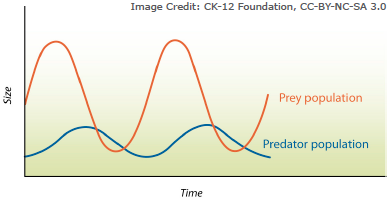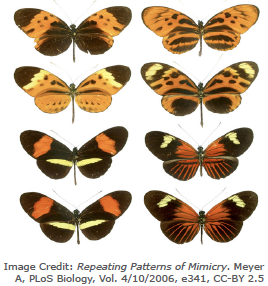Reading: Community Ecology Study Guide
Big Picture
A community is composed of all the populations of species that inhabit a specific area. Community ecology studies the interactions between such populations of species. Three important interspecific interactions are predation, competition, and symbiosis. The structure of communities also undergoes change due to abiotic and biotic disturbances, resulting in ecological succession.Key Terms
Predation: A relationship in which a member of one species, the predator, eats or preys on a member of another species, the prey.
Interspecific Competition: Competition between two or more species for the same resources.
Intraspecific Competition: Competition between members of one species for the same resources.
Symbiosis: A close relationship between two species that may benefit one or both species.
Parasitism: A relationship in which one organism (parasite) benefits at the other organism’s (the host’s) expense.
Mutualism: A relationship in which both species benefit.
Commensalism: A relationship in which one species benefits while the other is not affected.
Ecological Succession: The sequential change over time in the composition of a community.
Primary Succession: Ecological succession that takes place in a previously uncolonized area typically lacking soil.
Secondary Succession: Ecological succession that takes place in a previously colonized area that has been disturbed.
Pioneer Species: The first species to inhabit a previously uncolonized or disturbed area, leading to primary or secondary succession.
Disturbance: An occurrence that changes a community, such as a fire, drought, or animal movement Disturbances help maintain species diversity.
Keystone Species: A species that plays an important role in determining the structure of a community.
Community Interactions
Predation
• We usually think of carnivorous species like lions hunting animals for food as predation, but herbivorous species eating plants is also a type of predation.
• Predators and preys tend to keep their population in balance - when there is more prey, there is more food for predators, which allows the predator population to grow. With more predators, however, more prey is eaten, causing the prey population to drop. With less food, predator population also begins to drop.

• Keystone species play an especially important role in the community. A change in the population of keystone species will affect the populations of other species.
• Example: otters eat sea urchins, which can destroy kelp forests if their population is not kept in check. Keystone species do not have to be predators or at the top of the food chain. Otters, for example, are prey for sea lions and orcas (killer whales).
• Predation has caused mimicry to evolve as an adaptation in some species. Mimicry is when two species resemble each other so that one or both of the species gain an advantage with regard to survival. Two harmful species may resemble each other or a harmless species may imitate a harmful species in order to scare of prey.

Figure: Mimicry in butterflies
Competition
Two types of competition:
1. Interspecific competition
• Example: predators of different species competing for the same prey
• Can lead to competitive exclusion: competition over the same resources can lead to extinction or a shift/reduction in niche for the less successful competitor. In other words, “complete competitors cannot coexist.”
• Can lead to specialization, where competing species evolve different adaptations, or resource partitioning, where the existing resources are divided spatially (two competing species of fish live at different depths) or temporally (two competing species hunt at different times of the day)
2. Intraspecific competition
• Example: two male birds competing for the same mate
Symbiosis
• Parasitism: Has a (+/-) effect, where the relationship is positive for one species and negative for the other. The species that benefits is called the parasite. The species that feels the negative effect is the host. Parasites typically have a negative effect on the host’s health and ability to reproduce, at times killing the host.
• Mutualism: Has a (+/+) effect where the relationship is positive for both species.
• Commensalism: Has a (+/0) effect where the relationship is positive for one species but does not affect the other.

Ecological Succession
Communities are constantly changing. Ecological succession is a look at how a community changes over time.
• Primary succession looks at an area that has never been colonized before. The area usually has nothing but bare rock (no soil).
• Pioneer species, like bacteria and lichens that can live on rocks, come in first.
• With time, the rocks wear down and soil forms. Plants can move in once soil is available.
• Other organisms gradually move in.
• Secondary succession looks at an area that has been disturbed. The disturbance can be a fire, drought, animal movement, or human action such as farming.
• Occurs faster than primary succession because soil is already in place.
